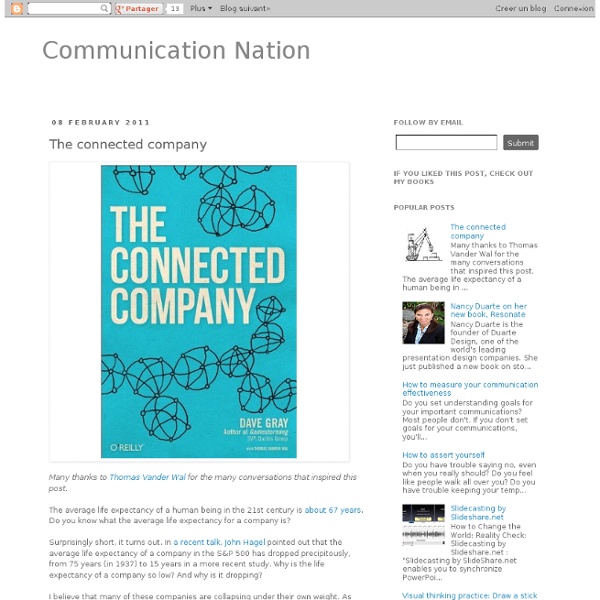Die drei wichtigsten Ziele eines Intranet 2.0 und wie man sie messen kann
Was sind eigentlich die Ziele eines Intranets? Auf den ersten Blick eine einfache Frage, auf den zweiten Blick ein weites Feld mit vielen verführerischen Allgemeinplätzen wie „Kommunikation“, „Informationsmedium“ oder „Zusammenarbeit“. Dabei können gut definierte Ziele als Leitfaden und Prüfstein dienen, an dem sich jede fachliche, technische und organisatorische Entscheidung im Rahmen einer Intranet Entwicklung messen lässt. Viele Elemente dieser Ziele sind erst mit den Ideen des Web 2.0 und seiner Umsetzung in einem Intranet 2.0 auf der Bildfläche erschienen – ein klassisches Intranet hat vor allem beim zweiten und dritten Ziel deutlich bescheidenere Ansprüche. Die folgende Aufteilung ist ein Versuch, die Ziele eines Intranets möglichst einfach aber auch konkret und umfassend darzustellen. Informationsverteilung ist die klassische Aufgabe von Intranets. Zentral verteilte Informationen machen nur den Bruchteil der Informationsflüsse und -bedürfnisse eines Unternehmens aus. Teilziele
Personal InfoCloud
CIPD publishes survey on talent management
A survey of talent management from the perspective of employees by the UK Chartered Institute for Personnel and Development found that coaching, mentoring and networking were valued above the more formal development opportunities offered by a talent management programme. Arranging a selection process beforehand was found to boost participants’ commitment to the programme. In addition, human resource managers play a critical role in coordinating talent pools and programmes. The recent talent management survey (590Kb PDF) carried out in the UK by the Chartered Institute for Personnel and Development (CIPD) focused on ‘very senior employees who are undertaking elements of organised talent development activity’. CIPD issued questionnaires to such employees in 11 medium to large organisations from a cross-section of sectors and received 302 responses. Seventeen follow-up interviews were also conducted by CIPD. Survey findings A report on the survey was published in June 2010.
The Flight From Conversation
At home, families sit together, texting and reading e-mail. At work executives text during board meetings. We text (and shop and go on Facebook) during classes and when we’re on dates. My students tell me about an important new skill: it involves maintaining eye contact with someone while you text someone else; it’s hard, but it can be done. Over the past 15 years, I’ve studied technologies of mobile connection and talked to hundreds of people of all ages and circumstances about their plugged-in lives. We’ve become accustomed to a new way of being “alone together.” Our colleagues want to go to that board meeting but pay attention only to what interests them. A businessman laments that he no longer has colleagues at work. A 16-year-old boy who relies on texting for almost everything says almost wistfully, “Someday, someday, but certainly not now, I’d like to learn how to have a conversation.” Texting and e-mail and posting let us present the self we want to be.
Unternehmensführung: 1 Grundlagen strategische Planung und Führung
"Unternehmen sind offene Systeme, denn sie agieren nicht autonom, sondern sind in vielfältiger Weise in die Systemumwelt eingebunden und dadurch Zwängen und Bedingungen ausgesetzt, die im Regelfall durch das System selbst als nicht veränderbar anzusehen sind." Die Aufgaben des Managements besitzen damit einen sehr komplexen Charakter. Während in der Psychologie ganzheitliche Konzepte bereits eine lange Tradition haben, ist dieser Ansatz in der Betriebswirtschaftslehre insbesondere im letzten Jahrzehnt stark diskutiert worden. In diesem Kapitel lernen Sie: den systemischen Ansatz auf Unternehmen anzuwenden,einen integrierten Ansatz des strategischen Managements zu erläutern,Ansätze der Unternehmensführung darzustellen,das Konzept der Strategieentwicklung zu beschreiben,Implementierungsansätze für Strategien zu bewerten.
More on Trust in the Social Enterprise
Note: This is the seventh in a series of posts about the Social Enterprise and the Big Shift. The first post provided an introduction and overall context; the second looked specifically at collaboration, working together; the third looked at optimising performance, enjoying work, working more effectively. The fourth, Doing By Learning, looked at how work gets done in the enterprise, and provided the context in which such flows should be seen. The fifth delved into the subject of flows in detail, and introduced the concept of enterprise social objects. The sixth looked more specifically at the role of trust in the social enterprise, and raised the possibility of using social objects as catalysts for building tacit trust. Background I wasn’t planning to write this post. Virtual Communities and Trust There should be a law against using the phrase Virtual Communities without invoking the name of Howard Rheingold, the doyen on that subject, the onlie begetter of that phrase.
Organisationskultur
Organisationskultur (englisch organizational culture, corporate culture) ist ein Begriff der Organisationstheorie und beschreibt die Entstehung und Entwicklung kultureller Wertmuster innerhalb von Organisationen. Bei Unternehmen oder Verwaltungen wird dieses Phänomen auch als Unternehmenskultur oder eben Verwaltungskultur bezeichnet. Die Organisationskultur wirkt auf alle Bereiche des Managements (Entscheidungsfindung, Führung, Beziehungen zu Kollegen, Kunden und Lieferanten, Kommunikation usw.). Jede Aktivität in einer Organisation ist auf Basis ihrer Kultur entstanden und dadurch kulturell beeinflusst. Das Selbstverständnis der Organisationskultur erlaubt es Organisationsmitgliedern, Ziele besser verwirklichen zu können. Außenstehende können durch diese Kenntnis die Organisation besser verstehen. Grundlagen[Bearbeiten] Das Konzept der Organisationskultur überträgt den Kulturgedanken aus der Kulturanthropologie auf Organisationen. Hier sei vor allem Edgar H. „So machen wir das hier
Universität Potsdam - Kommunalwissenschaftliches Institut
Kommunalwissenschaftliches Institut der Universität Potsdam Lexikon zu Verwaltungsreform Leistungen, Produkte Leistungsanreize Leistungsanreize ist der Inbegriff aller Maßnahmen der Dienstherren, die die Leistungsbereitschaft (Motivation) einzelner oder mehrerer Mitarbeiter positiv beeinflussen und durch zusätzliche materielle oder immaterielle Belohnungen verstärken. Leistungsrechnung, Kosten- und Leistungsrechnung Leistungstiefe Unter dem Begriff Leistungstiefe wird analog zur Fertigungstiefe von Industrieunternehmen diskutiert, in welchem Umfang und in welcher Qualität Leistungen selbst erstellt oder von außen bezogen werden sollen. Leistungsvergleich Als Leistungsvergleich bezeichnen wir allgemein die gegenüberstellende systematische Erfassung wirtschaftlicher, technischer oder sozialer Daten von Organisationseinheiten oder einzelnen Leistungen oder Produkten. Leistungsverrechnung Leitbilder Lernende Organisation



